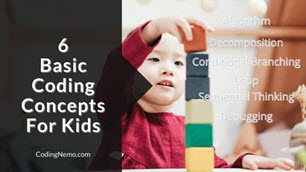
We know there are many benefits to teaching kids to code. But coding could be either fun or confusing for them. What are the basic coding concepts for kids to learn at the start? I decided to find out.
Kids can learn about coding concepts by playing games or from daily life activities. The 6 basic coding concepts kids can and should learn include Algorithm, Decomposition, Conditional Branching, Loop, Sequential Thinking, and Debugging. These skills also provide them with essential skills for life.
Introducing coding concepts to kids does not need to be complex or tedious. In fact, you might not realize that we have been practicing the same concepts in our daily life. In the remainder of this blog post, I want to show you what these basic coding concepts are, and how you can teach or explain them to our future coders.
6 Basic Coding Concepts For Kids as young as 5 years old to learn
Coding Concept 1: Algorithms
This is one of the most important concepts all coders need to understand.
A computer program is a set of instructions a programmer gives to a computer. We want the computer to complete a specific task. A computer is just a machine that executes the instructions. Technically, we call it an algorithm.
In other words, an algorithm refers to the sequential instructions given to a computer to solve a problem.
To teach kids about the concept of the algorithm, we want them to come out with a solution for a specific problem.
For example, ask your kids or students thinking about what they need to get ready before leaving for school every morning.
- Step 1: Breakfast
- Step 2: Put on school uniform
- Step 3: Check the school bag
- Step 4: get into the car
This is a set of sequential instructions to solve a problem – Get Ready For School. That’s how an algorithm works.
Coding Concept 2: Decomposition
Following the Algorithm, the next important coding concept is Decomposition.
Just as the name suggests, we need to learn to “decompose” a large problem into smaller and manageable parts. We then focus on solving the small parts. Each small part is simpler to work with, so they are easier to solve and manage.
Understanding the concept of decomposition will improve kids’ problem-solving skills. It does not only help in programming but also their academic performance later.
But, do you expect a 5-year-old to understand the term “Decomposition”? I do not.
Josh Darnit has a series of “Exact Instruction Challenge” videos where his kids are tasked to write out exact instructions for him to do something, for example, making a peanut butter sandwich.
This video is fun and educational, it gives you the ideas to teach kids about decomposition.
The key is to teach them how to break a task into small parts so that the person or computer can understand and execute.
Coding Concept 3: Conditional Branching
Conditional Branching in computer science uses If/else statements to create branches of code in your program. Computers execute a specific part of the code when the condition is met.
Of course, this explanation would be too difficult for kids to understand. We can make a connection between this concept to daily life.
“If the school bell rings, then you need to get back to the classroom and sit down. Otherwise, you are allowed to play at the playground”.
“If Today is Thursday, then put on the sports uniform for school, otherwise, wear a formal uniform for school.”
“If the teacher is talking then I need to be quiet and listen”
These are conditional branching examples.
Block programming language like Scratch offers if-then-else visual blocks for kids to apply the conditional concepts in their coding:

What does the coding block above do?
when an Up Arrow key is pressed, the character will move 10 steps, otherwise, it will turn 15 degrees.
When a connection is established in their daily routine, it helps kids to understand a coding concept easily and quickly.
Coding Concept 4: Loop
Looping might be the easiest coding concept for kids to understand. In programming, a loop allows you to repeat actions over and over again.

You can control a loop by giving the number of repeats it needs to do or have the loop stop when a condition is met.
To teach the looping concept to kids, we can use a daily activity such as eating breakfast to explain.
The loop can go like this:
While there are cornflakes in the bowl, I will keep eating until the bowl is empty.
OR
While there is apple juice in my cup, I will keep drinking until the cup is empty.
Or
While the song is still playing, we will keep dancing until the music stops.
Programmers use loops to make their programs efficient. Instead of writing multiple repeating statements, we can use a loop statement or block.
For kids, instead of repeatedly telling them to “eat one more spoon of cornflake”, we replace it with a loop. We say “keep eating the corn flakes until the bowl is empty”.
Coding Concept 5: Sequential thinking
Sequential thinking is a simple, yet important coding concept for coders. It is the ability to sort problems into orders and solve them in the correct sequence.
Sequential thinking does not only benefit coding, it helps kids to excel in math, reading, and writing. In other words, having a good grasp of sequential thinking will improve a child’s academic performance.
To teach kids about sequential thinking, we want them to slow down and think about things in sequential manners. Get them to develop step-by-step solutions for small problems.
The simplest way to teach younger kids about sequential thinking is by challenging them to arrange numbers or alphabets in the correct order.
Coding Concept 6: Debugging
Debugging is the ability to identify and fix errors in code. It is an important skill for coders to master.
Mastering debugging skills goes a long way for kids. It helps to build their problem-solving skills and teaches them to be persistent which will be beneficial to their academic and future careers.
To teach kids about debugging, the basic idea is to make them understand debugging is to fix a problem.
For younger kids, you can teach them about debugging by playing Maze. Parents or teachers write out simple instructions for kids to follow. Make a deliberate mistake in the instructions which eventually leads kids to the obstacle. Challenge kids to figure out the mistake and offer a correct solution.
Debugging could be a frustrating experience. Kids tend to become impatient and give up easily. It is important to encourage them to be resilient and offer them small hints when they are stuck.
Basic coding concepts for kids to get started – Wrap Up
Coding is fun and beneficial for kids. Teaching kids to code does not mean we want them to become a professional coder. Coding is a skill that will help them in many aspects of life.
To teach young kids about coding, remember to make them fun, and get them interested. Making learning to code an enjoyable journey.


